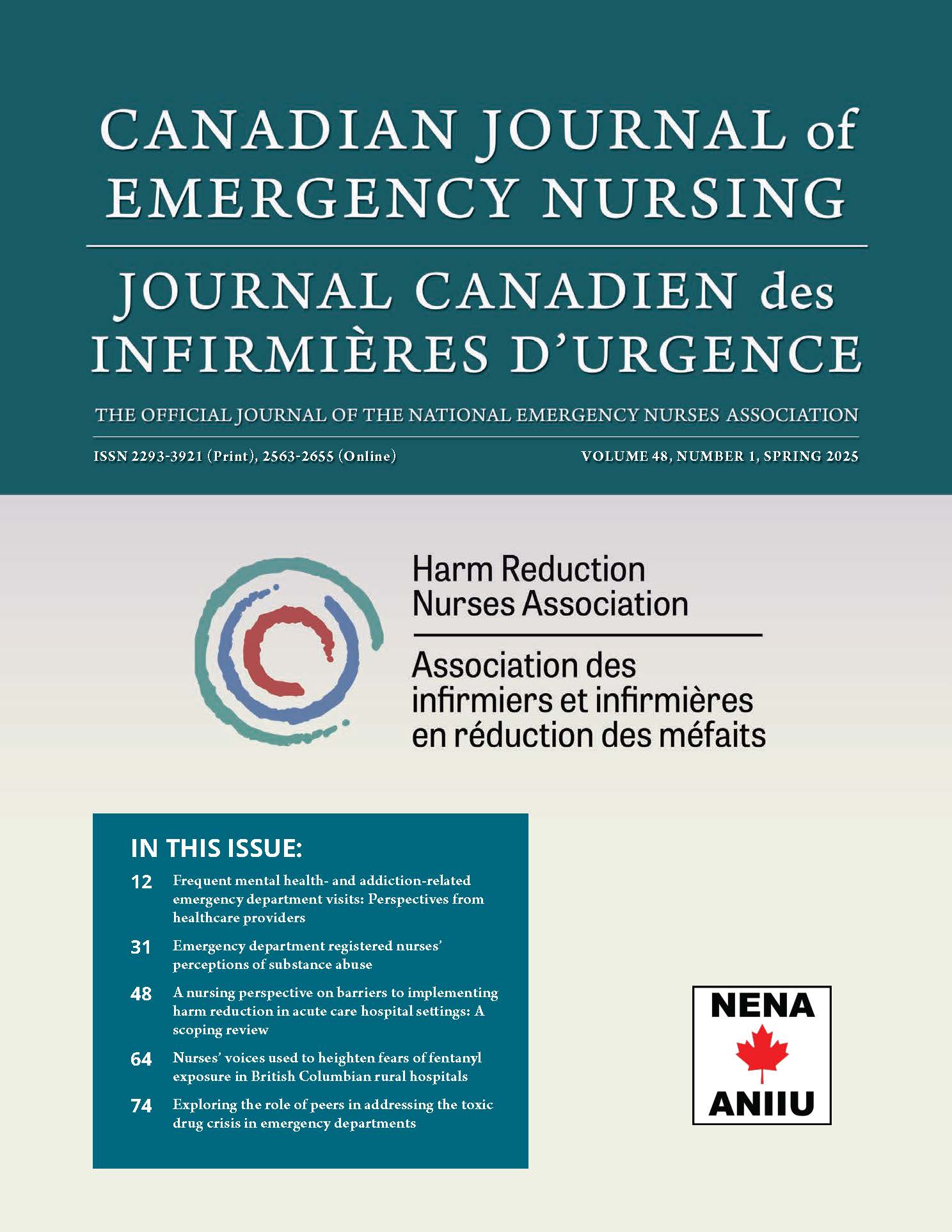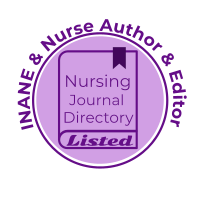La voix du personnel infirmier instrumentalisée pour amplifier les peurs liées à l’exposition au fentanyl dans les hôpitaux ruraux de la Colombie-Britannique
DOI :
https://doi.org/10.29173/cjen247Mots-clés :
exposition professionnelle, profession de soins infirmiers, troubles liés à l’utilisation de substances, politique en matière de drogues, plaidoyerRésumé
Les personnes qui consomment des drogues (PUD) font l’objet d’une stigmatisation lorsqu’elles accèdent aux soins de santé en milieu hospitalier, y compris aux soins d’urgence. Les régions rurales sont particulièrement concernées en raison de la stigmatisation sociale et structurelle accrue à l’égard de ces personnes dans les petites communautés. Ces obstacles ont été amplifiés par les récents récits des médias et de l’attention politique sur les risques encourus par les prestataires de soins de santé lorsqu’ils sont exposés à des PUD qui consomment des drogues pendant leur hospitalisation. La voix du personnel infirmier a été instrumentalisée, directement et indirectement, pour influencer les discours politiques et susciter une panique morale face à l’exposition sur le lieu de travail à la fumée secondaire de substances non réglementées (par exemple, le fentanyl et la méthamphétamine). Le climat politique actuel en Colombie-Britannique au Canada exige une action collective immédiate de la part du personnel infirmier afin de protéger ses obligations professionnelles et éthiques et d’assurer un accès sûr et libre de toute stigmatisation aux soins hospitaliers pour les PUD dans les zones rurales.
Références
Bardwell, G., Mansoor, M., Van Zwietering, A., Cleveland, E., Snell, D., & Kerr, T. (2022). The “goldfish bowl”: A qualitative study of the effects of heightened surveillance on people who use drugs in a rural and coastal Canadian setting. Harm Reduction Journal, 19(1), 136. https://doi.org/10.1186/s12954-022-00725-2
Barry, C. L., McGinty, E. E., Pescosolido, B. A., & Goldman, H. H. (2014). Stigma, Discrimination, Treatment Effectiveness, and Policy: Public Views About Drug Addiction and Mental Illness. Psychiatric Services, 65(10), 1269–1272. https://doi.org/10.1176/appi.ps.201400140
BC Nurses Union. (2024, May 7). Controlling Exposure Risks from Illicit Substances. https://www.bcnu.org/a-safe-workplace/health-and-safety/controlling-exposure-risks
Bourque, S., Pijl, E. M., Mason, E., Manning, J., & Motz, T. (2019). Supervised inhalation is an important part of supervised consumption services. Canadian Journal of Public Health, 110(2), 210–215. https://doi.org/10.17269/s41997-019-00180-w
Burgess, A., Bauer, E., Gallagher, S., Karstens, B., Lavoie, L., Ahrens, K., & O’Connor, A. (2021). Experiences of stigma among individuals in recovery from opioid use disorder in a rural setting: A qualitative analysis. Journal of Substance Abuse Treatment, 130, 108488. https://doi.org/10.1016/j.jsat.2021.108488
Chan Carusone, S., Guta, A., Robinson, S., Tan, D. H., Cooper, C., O’Leary, B., de Prinse, K., Cobb, G., Upshur, R., & Strike, C. (2019). “Maybe if I stop the drugs, then maybe they’d care?”—Hospital care experiences of people who use drugs. Harm Reduction Journal, 16(1), 16. https://doi.org/10.1186/s12954-019-0285-7
DeBeck, K., Cheng, T., Montaner, J. S., Beyrer, C., Elliott, R., Sherman, S., Wood, E., & Baral, S. (2017). HIV and the criminalisation of drug use among people who inject drugs: A systematic review. The Lancet HIV, 4(8), e357–e374. https://doi.org/10.1016/S2352-3018(17)30073-5
DeRosa, K. (2024, April 5). Nurses speak out about consequences of drug use in hospitals. https://vancouversun.com/news/nurses-speak-out-about-consequences-of-drug-use-in-hospitals
Dogherty, E., Patterson, C., Gagnon, M., Harrison, S., Chase, J., Boerstler, J., Gibson, J., Gill, S., Nolan, S., & Ryan, A. (2022). Implementation of a nurse-led overdose prevention site in a hospital setting: Lessons learned from St. Paul’s Hospital, Vancouver, Canada. Harm Reduction Journal, 19(1), 13. https://doi.org/10.1186/s12954-022-00596-7
Eagland, S., Ranger, C. & Wilson, P. (2024, May 23). Fears of exposure to illicit drugs in public places based on politics, not facts. https://healthydebate.ca/2024/05/topic/exposure-illicit-drugs-politics/
Ellis, K., Walters, S., Friedman, S. R., Ouellet, L. J., Ezell, J., Rosentel, K., & Pho, M. T. (2020). Breaching trust: Qualitative study of healthcare experiences of people who use drugs in a rural setting. Frontiers in Sociology, 5, 593925. https://doi.org/10.3389/fsoc.2020.593925
Fisher, J. (2007). Mental health nurses: De facto police. International Journal of Mental Health Nursing, 16(4), pp. 230-235. https://doi.org/10.1111/j.1447-0349.2007.00472.x
Fleming, P. & Sinnot, M-L. (2018). Rural physician supply and retention: Factors in the Canadian context. Canadian Journal of Rural Medicine, 23(1). https://www.srpc.ca/resources/Documents/CJRM/vol23n1/pg15.pdf
Hatzenbuehler, M. L., Phelan, J. C., & Link, B. G. (2013). Stigma as a fundamental cause of population health inequalities. American Journal of Public Health, 103(5), 813–821. https://doi.org/10.2105/AJPH.2012.301069
Henderson, S. (2002). Factors impacting on nurses’ transference of theoretical knowledge of holistic care into clinical practice. Nurse Education in Practice, 2(4), 244–250. https://doi.org/10.1016/S1471-5953(02)00020-3
Hu, K., Klinkenberg, B., Gan, W. Q., & Slaunwhite, A. K. (2022). Spatial-temporal trends in the risk of illicit drug toxicity death in British Columbia. BMC Public Health, 22(1), 2121. https://doi.org/10.1186/s12889-022-14586-8
Kennedy-Hendricks, A., Barry, C. L., Gollust, S. E., Ensminger, M. E., Chisolm, M. S., & McGinty, E. E. (2017). Social stigma toward persons with prescription opioid use disorder: Associations with public support for punitive and public health–oriented policies. Psychiatric Services, 68(5), 462–469. https://doi.org/10.1176/appi.ps.201600056
McEachern, J., Ahamad, K., Nolan, S., Mead, A., Wood, E., & Klimas, J. (2016). A Needs Assessment of the Number of Comprehensive Addiction Care Physicians Required in a Canadian Setting. Journal of Addiction Medicine, 10(4), 255. https://doi.org/10.1097/ADM.0000000000000230
Moss, M. J., Warrick, B. J., Nelson, L. S., McKay, C. A., Dubé, P.-A., Gosselin, S., Palmer, R. B., & Stolbach, A. I. (2018). ACMT and AACT position statement: Preventing occupational fentanyl and fentanyl analog exposure to emergency responders. Clinical Toxicology, 56(4), 297–300. https://doi.org/10.1080/15563650.2017.1373782
Muncan, B., Walters, S. M., Ezell, J., & Ompad, D. C. (2020). “They look at us like junkies”: Influences of drug use stigma on the healthcare engagement of people who inject drugs in New York City. Harm Reduction Journal, 17(1), 53. https://doi.org/10.1186/s12954-020-00399-8
Neale, J., Tompkins, C., & Sheard, L. (2008). Barriers to accessing generic health and social care services: A qualitative study of injecting drug users. Health & Social Care in the Community, 16(2), 147–154. https://doi.org/10.1111/j.1365-2524.2007.00739.x
Palombi, L. C., St Hill, C. A., Lipsky, M. S., Swanoski, M. T., & Lutfiyya, M. N. (2018). A scoping review of opioid misuse in the rural United States. Annals of Epidemiology, 28(9), 641–652. https://doi.org/10.1016/j.annepidem.2018.05.008
Pauly, B. (Bernie), McCall, J., Browne, A. J., Parker, J., & Mollison, A. (2015). Toward Cultural Safety: Nurse and Patient Perceptions of Illicit Substance Use in a Hospitalized Setting. Advances in Nursing Science, 38(2), 121–135. https://doi.org/10.1097/ANS.0000000000000070
Shaw, R. (2024, April 4). ‘Nobody signed up.. to be exposed to fentanyl in the workplace’ says nurse. https://northernbeat.ca/opinion/nobody-signed-up-to-be-exposed-to-fentanyl-in-the-workplace-says-nurse/
Stangl, A. L., Earnshaw, V. A., Logie, C. H., van Brakel, W., C. Simbayi, L., Barré, I., & Dovidio, J. F. (2019). The Health Stigma and Discrimination Framework: A global, crosscutting framework to inform research, intervention development, and policy on health-related stigmas. BMC Medicine, 17(1), 31. https://doi.org/10.1186/s12916-019-1271-3
Sweetman, M. (2024, November 21). Patient overdose death at Nanaimo hospital ‘didn’t have to happen,’ doctor says. https://thediscourse.ca/nanaimo/patient-overdose-death-at-nanaimo-hospital-didnt-have-to-happen-doctor-says
Taylor, A. (2024, May 7). Campbell River hospital staff exposed to illicit drug smoke: Island Health. https://www.campbellrivermirror.com/local-news/campbell-river-hospital-staff-exposed-to-illicit-drug-smoke-island-health-7326961
Van Boekel, L. C., Brouwers, E. P. M., Van Weeghel, J., & Garretsen, H. F. L. (2013). Stigma among health professionals towards patients with substance use disorders and its consequences for healthcare delivery: Systematic review. Drug and Alcohol Dependence, 131(1–2), 23–35. https://doi.org/10.1016/j.drugalcdep.2013.02.018
Van Dyk, S. (2024, May 7). The federal government grants B.C.’s request to recriminalize hard drugs in public spaces. https://www.ctvnews.ca/politics/federal-government-grants-b-c-s-request-to-recriminalize-hard-drugs-in-public-spaces-1.6876913
Vancouver Coastal Health. (2023, January 1). Possession of controlled substances for personal use. https://www.vch.ca/en/decriminalization-controlled-substances-personal-use
Téléchargements
Publié-e
Comment citer
Numéro
Rubrique
Licence
© Kate Hodgson, Amanda Lavigne, Geoff Bardwell 2025

Cette œuvre est sous licence Creative Commons Attribution 4.0 International.
The Canadian Journal of Emergency Nursing is published Open Access under a Creative Commons CC-BY 4.0 license. Authors retain full copyright.




